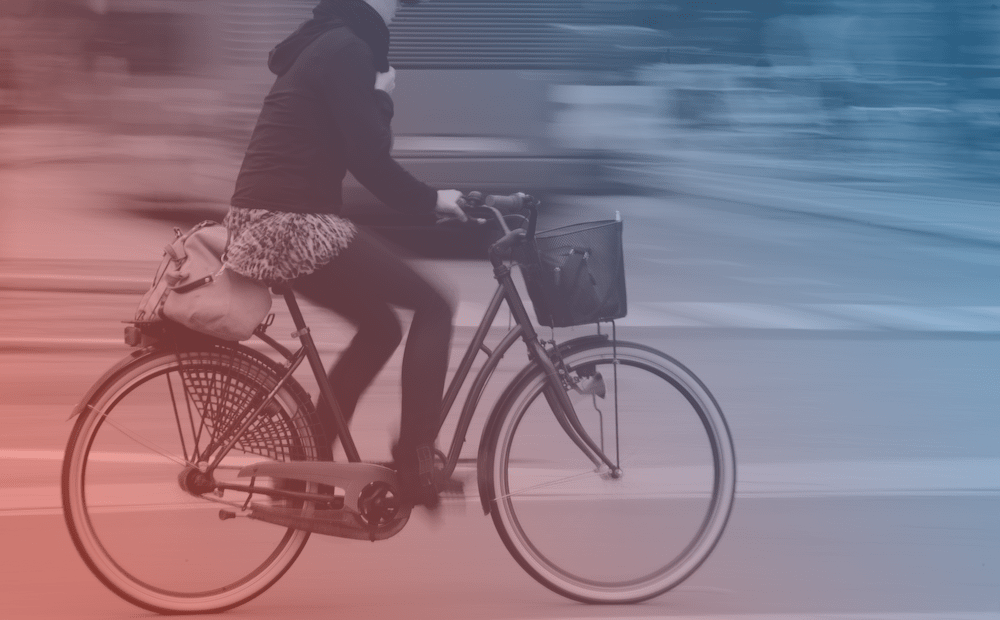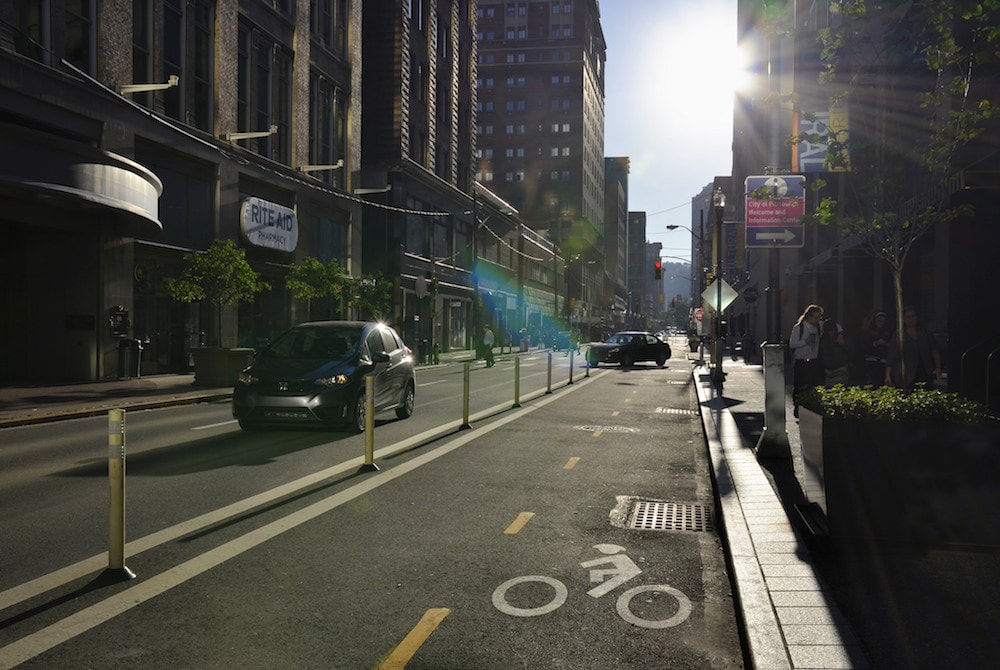City Cyclists Crowdsource The Safest Path
4:33 minutes

 This segment is part of The State of Science, a series featuring science stories from public radio stations across the United States. A version of this story, by Joaquin Gonzalez, originally appeared on 90.5 WESA in Pittsburgh, Pennsylvania.
This segment is part of The State of Science, a series featuring science stories from public radio stations across the United States. A version of this story, by Joaquin Gonzalez, originally appeared on 90.5 WESA in Pittsburgh, Pennsylvania.
Pittsburgh can be notoriously difficult to navigate. The city’s hills and valleys, bridges and tunnels, lack of street grid, one-way streets, and constant construction make getting around a feat, even in a car.
That challenge is only multiplied while riding a bicycle, when safety becomes a top concern.
“The biggest barrier to people riding a bike is typically uncertainty or fear of the unknown, as well as obviously cars and traffic,” said cyclist and web developer Lynsie Campbell. “If we can give people as much information [as possible] about the roads they’re going to travel before they head out, they can make good decisions.”

Campbell had been a bike commuter for years, but when she moved from San Francisco back to Pittsburgh with her young son and started cycling with him, she became especially concerned with finding the safest routes to bike—and sharing that information with others.
[This device visualizes your climate change future.]
That was the inspiration behind the website and mobile app LaneSpotter, which Campbell hopes will become the “definitive guide” for anyone who rides a bike.
LaneSpotter has three main functions. The bike map shows cyclists where they can find bike lanes or trails in their area. The safety map lets users create and view ratings for any road, ranging from “very safe” to “avoid.” The alerts map lets users flag problems like road closures or heavy traffic in real-time, similar to the Waze navigation app for drivers.
Campbell said that while online resources to find bike lanes and routes already exist, having a little more context can be very helpful.
“Just because there’s a bike lane on the road doesn’t necessarily mean it’s the safest road to travel,” said Campbell. “My example of this in Pittsburgh is Forbes Avenue, between Braddock and South Dallas. There’s a bike lane there, but there’s also four lanes of traffic going 50 in a 35 mph zone. So it’s deceiving, and if you don’t know that and you get on that road … you might not be comfortable.”
[Rainy day? Microbes may be at play.]
LaneSpotter has partnered with Bike Pittsburgh and similar advocacy groups in nine other cities across the United States, including New York and Washington, D.C., in order to get the word out to cyclists. But Campbell said cyclists have created ratings on the app in more than 250 cities and communities around the world.
“Anyone who finds the app can get a group of people together and start rating the roads in their city and that’s kind of the beauty of this,” said Campbell.
Ratings can be found in European cities such as London and Berlin, and there’s an especially active group of users in and around the city of Toyama on the west coast of Japan.
Campbell said the next steps are to secure more funding for LaneSpotter and develop a revenue model that preserves users’ rights to protect their personal data.
Joaquin Gonzalez is a content producer at WESA in Pittsburgh, Pennsylvania.
IRA FLATOW: And now it’s time to check in on the state of science.
SPEAKER 2: This is [INAUDIBLE]–
SPEAKER 3: For WWNO–
SPEAKER 4: St. Louis public radio–
SPEAKER 2: KQED news.
SPEAKER 5: Iowa Public Radio news.
Local stories with a national impact– if you’re a fan of cycling in the city, and who is not, you know that not all bike lanes are created equal. And now there’s an app that will give you not only your fastest route to work, but also maybe the safest way to get there. Here to tell us more about this is WESA reporter Joaquin Gonzalez. Joaquin, welcome to Science Friday.
JOAQUIN GONZALEZ: Thank you, Ira.
IRA FLATOW: Congratulations are in order. You’re a citizen today.
JOAQUIN GONZALEZ: Yeah, that’s right, just as of this morning.
IRA FLATOW: Congratulations.
JOAQUIN GONZALEZ: Thank you very much.
IRA FLATOW: Let’s talk about this app. It’s called the LaneSpotter, is that right?
JOAQUIN GONZALEZ: Yes, LaneSpotter.
IRA FLATOW: And how does that work?
JOAQUIN GONZALEZ: It’s a little bit similar to the apps like Waze or Google Maps used for navigation. So the interface does look like a map. And users can go on there and create a route or directions to cycle from point A to point B. And a similarity with Waze is that they can actually see what you might call alerts, which are instances where another user has flagged some kind of road condition, which could be like a closure or construction. Here in Pittsburgh, it’s, a lot of times it’s potholes, which we’re kind of notorious for.
IRA FLATOW: I hate it when that happens, when you hit a pothole.
JOAQUIN GONZALEZ: It’s maybe even scarier and then when you’re in a car. Maybe the key thing with LaneSpotter is that it also lets users create safety ratings for any roads. So not just trails, or not even just roads with bike lanes, but really any street. And they can give it a rating from very safe to avoid on a five-point scale.
And so what LaneSpotter actually does is when it’s creating a route or directions for you, it takes those safety ratings into account once a certain amount have been created. And it tries to optimize your route, and it gives you the best combination of the most direct route and the safest route.
IRA FLATOW: Is this something that the bicyclists have always wanted? Were they always looking for an app like this?
JOAQUIN GONZALEZ: Yeah, so the app’s founder, her name is Lynsie Campbell. She’s a longtime cyclist and bike commuter. She’s done this in multiple cities. And she’s gotten to know a lot of other cyclists. So she’s pretty well attuned to their needs, I would say. Two big concerns, or maybe motivations, that she brought up when we spoke were– the first one was that there’s varying levels of skill and experience among cyclists. And this is especially true as cycling becomes more popular, and things like bike shares become more popular. Increasingly that’s going to include a lot of beginners.
And then the second thing is that from street to street, there’s also varying degrees of difficulty and safety from one street to another. And that can be the case even when there’s bike lanes. So just because a road has a bike lane doesn’t necessarily mean that it will be the easiest or safest right. And when we spoke, Lynsie gave me an example of this using a stretch of road here in Pittsburgh.
LYNSIE CAMPBELL: My example of this in Pittsburgh is Forbes Avenue between Braddock and South Dallas. There’s a bike lane there, but there’s also four lanes of traffic going 50 in a 35 MPH zone.
IRA FLATOW: Wow. That’s pretty dangerous, right? You don’t want to be in that kind– so then you can look at the app and I’ll tell you stay out of that [INAUDIBLE]?
JOAQUIN GONZALEZ: Exactly.
IRA FLATOW: So this is for working people who are commuting to work, right?
JOAQUIN GONZALEZ: It’s for both. It’s for bike commuters, casual bikers. Really, how Lynsie described it is anybody who rides a bike, she wants them to have this resource.
IRA FLATOW: So the users of the app are having safer experiences? Are they reporting the app is helping them?
JOAQUIN GONZALEZ: Yeah I believe so. So Lynsie said she’s gotten a lot of positive feedback. And also, maybe user involvement is a good way to gauge how useful people are finding it. So LaneSpotter has been able to partner with bike advocacy groups, not just here in Pittsburgh, but in a handful of larger cities around the country. So what you’re seeing now is that cities like New York, San Francisco, St. Louis, Cleveland, and a handful of others are pretty well mapped out with their safety ratings.
IRA FLATOW: I guess, besides bicyclists, I guess if you’re a motorist, too. I’m thinking about this now. You look out and see what roads that bike cyclists are going to be on, and maybe be a little bit more careful when you drive on them.
JOAQUIN GONZALEZ: Yeah. You know, I hadn’t thought about it. But I think that’s really true. I mean, the dynamic, obviously, on a motorcycle is much closer to what you see on a bike versus being in a car.
IRA FLATOW: OK. Well, Joaquin, thank you very much for joining us.
JOAQUIN GONZALEZ: Thank you, Ira.
IRA FLATOW: Joaquin Gonzalez, reporter for WESA here in Pittsburgh. And we’re going to take a break. When we come back, what’s stronger than steel, conducts electricity better than copper, and is making waves in the world of biomedicine? We’re going to talk about graphene. Yeah we’ve talked a lot about it. We’ll talk about another possible use for it. Stay with us. We’ll be right back after this break.
Copyright © 2018 Science Friday Initiative. All rights reserved. Science Friday transcripts are produced on a tight deadline by 3Play Media. Fidelity to the original aired/published audio or video file might vary, and text might be updated or amended in the future. For the authoritative record of Science Friday’s programming, please visit the original aired/published recording. For terms of use and more information, visit our policies pages at http://www.sciencefriday.com/about/policies/
Katie Feather is a former SciFri producer and the proud mother of two cats, Charleigh and Sadie.